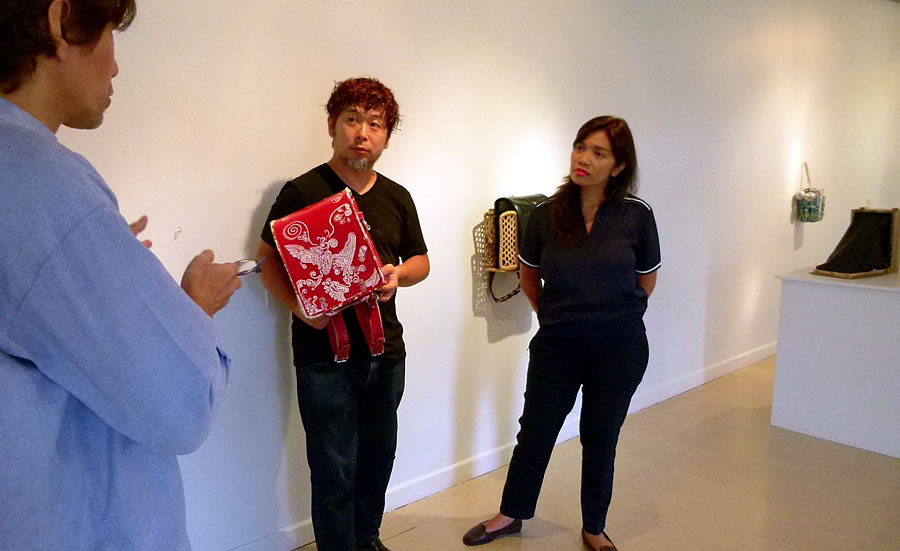ON the third day, November 14, 2015, of the Field Trip Project Asia: Philippines exhibition at UP Vargas Museum, diskurso.com interviewed Japanese-Canadian artist Daisuke Takeya and Filipino curator Laya Boquiren, co-curators of the show, about the poignant project. Although the show itself included works by 42 other contemporary artists from Asia and the Pacific, the exhibition poster highlighted the names of Filipino artists chosen by Boquiren, including Manila and Osaka-based artist Mark Salvatus; sculptors Mervy Pueblo, Noell El Farol and Paul Albert Quiano; crochet artist Aze Ong; weaver Jason Domling; Baguio-based artist Jhoan Medrano; and 98B artCOLLABoratory artist Anjo Bolarda. The choice of UP Vargas Museum as the venue for the show was logical, being one of the purported centers of Philippine contemporary art, thanks perhaps to its having contemporary art critic Patrick Duarte Flores as resident curator. Flores was also Boquiren’s graduate program mentor. And though Takeya is Canada-based, his involvement in the relief efforts for victims of the 2011 Tōhoku earthquake and tsunami, and in the on-site trauma release art workshops in the temporary housing in Onagawa thereafter, would lead to this idea of using randoseru bags as both canvas (or main sculpture ingredient) and traveling “conversation pieces” (as Boquiren would put it). That is also why Boquiren was able to get main sponsorship for this show to travel here from the Japan Foundation and The Japan Foundation Asia Center.
HERE’S how it all started. Among the food, clothing, and blankets sent in as relief supplies to that tsunami disaster area were randoseru backpacks for the children victims. For everyone’s information, randoserus are firm-sided backpacks made of either stitched firm leather or synthetic leather used in Japan by elementary school children. Randoserus are given to Japanese children upon their entry into grade school, and, traditionally, each child is expected to wear the same firm-sided backpack until Grade Six.”At the end of March in 2012, a year after the disaster,” wrote Takeya in the project catalog, “large amounts of relief supplies were still filling up local school gymnasiums as surplus and were soon to be discarded.” Takeya was referring to a period when the idea struck him to use the backpacks as material for the trauma release art workshops, noting that the backpacks are “a metaphor for affection, learning and childhood memories” in Japan. He then later thought of commissioning Canadian and Japanese artists to transform the surplus backpacks into artworks, thereafter bringing back these transformed pieces into the disaster areas to connect them with the original interactive trauma-release art program. Pretty soon, after a two-week first exhibition of these backpacks at the Onagawa temporary housing (Onagawa was one of the municipalities most heavily damaged by the tsunami), a show curated by the survivor children of the municipality themselves, the backpacks traveled Japan without Takeya’s having planned it to become a traveling exhibition. It simply saw itself starting to travel from the perspective of Takeya’s need to expose “the difficulty of balancing support from outside with actual local needs.” Using the exhibition as a vehicle, it seemed to Takeya then that “two-way communication was an absolute necessity.” And so the backpacks traveled to about twenty destinations in Japan. Takeya also noted that, soon afterwards, instead of “having serious in-depth conversations about the disaster” around the backpacks as conversation pieces, “we shared unique local issues at each destination.” Now, wearing “the artworks gave people a chance to share memories, and we had rather light, and possibly sustainable, introductory dialogues about environmental and natural disasters.” Here is what interests me about this. Should artworks really be themselves, as in the Structuralist ideal or in the l’art pour l’art utopia? Or can artworks be both perfect as themselves as well as vehicles for further conversation on topics near the intent of the artmaking and even topics far removed from the springboard? But to continue our narrative, it was at the height of these backpacks’ touring of Japan that Boquiren got wind of the phenomenal randoseru traveling show, which tickled her curiosity and interest as a member of an East Asia study group at the university where she teaches art history (University of Asia and the Pacific) and as once a short-term creative industries management course participant in Keio University as well as being once a Baguio-raised kid who now remembers her childhood with the pasiking and as a survivor of the 1990 Luzon earthquake. She contacted Takeya through her curator friends and broached to the artist the possibility of bringing the traveling show to the Philippines. It turned out that Takeya had a similar invitation to bring the show to Singapore.
